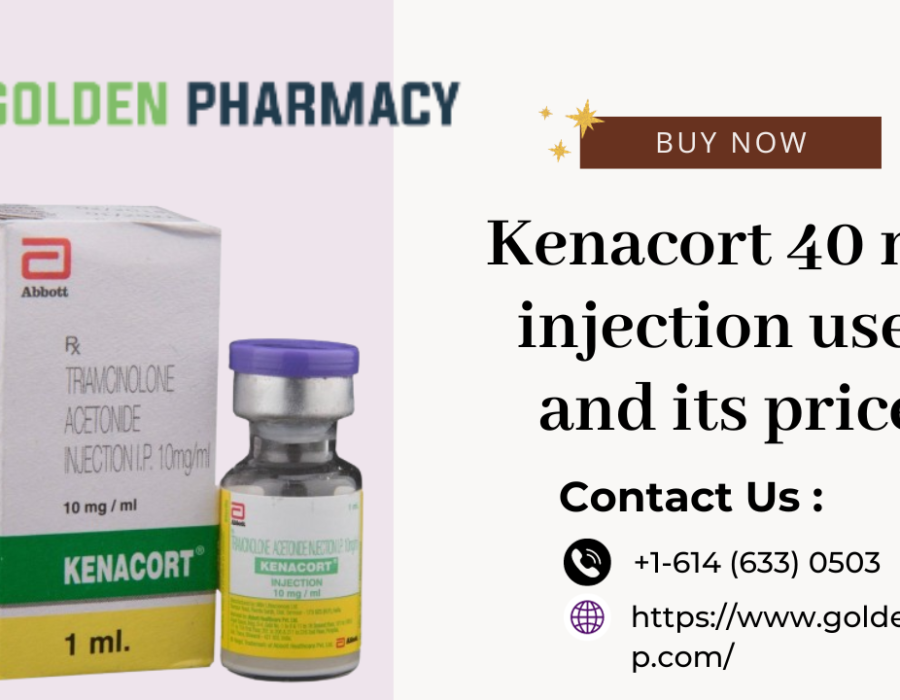Understanding Kenacort 40 mg Injection
What is Kenacort 40 mg Injection?
Kenacort 40 mg injection is a form of triamcinolone acetonide, a synthetic corticosteroid. Corticosteroids mimic the effects of hormones produced by the adrenal glands, helping to regulate inflammation and immune response in the body.
1.2 Mechanism of Action
The active ingredient, triamcinolone acetonide, works by suppressing the release of inflammatory substances in the body, thereby reducing inflammation and immune system activity.
Medical Uses of Kenacort 40 mg Injection
2.1 Treatment of Inflammatory Conditions
Kenacort 40 mg injection is commonly prescribed for various inflammatory conditions such as rheumatoid arthritis, osteoarthritis, and other joint disorders. It effectively alleviates pain and reduces inflammation in affected joints.
2.2 Dermatological Conditions
Dermatologists often use Kenacort 40 mg injection to treat skin conditions like psoriasis, eczema, and allergic reactions. The anti-inflammatory properties help relieve itching, redness, and swelling associated with these conditions.
2.3 Respiratory Conditions
In some cases, Kenacort 40 mg injection may be used to manage respiratory conditions like asthma. It helps to reduce inflammation in the airways, improving breathing and overall lung function.
2.4 Allergic Reactions
Kenacort 40 mg injection is employed to address severe allergic reactions, providing rapid relief from symptoms like swelling, itching, and hives.
Benefits and Efficacy
3.1 Quick Onset of Action
One of the notable benefits of Kenacort 40 mg injection is its rapid onset of action. This makes it particularly effective in managing acute inflammatory conditions where prompt relief is crucial.
3.2 Localized Treatment
The injection can be administered directly into the affected area, ensuring a targeted and localized treatment approach. This is advantageous in conditions like arthritis or dermatological issues where precision is essential.
3.3 Long-Lasting Effects
Kenacort 40 mg injection's sustained anti-inflammatory effects contribute to its effectiveness in providing relief over an extended period, reducing the frequency of administration.
Section 4: Potential Side Effects and Precautions
4.1 Common Side Effects
While Kenacort 40 mg injection is generally well-tolerated, some individuals may experience side effects such as pain at the injection site, skin changes, or temporary facial flushing.
4.2 Systemic Effects
Long-term or frequent use of corticosteroids like Kenacort 40 mg injection may lead to systemic side effects, including weight gain, fluid retention, increased blood pressure, and mood changes.
4.3 Precautions and Contraindications
Healthcare providers consider individual patient factors, including existing medical conditions and medications, before prescribing Kenacort 40 mg injection. It may not be suitable for certain individuals, such as those with a history of allergic reactions to corticosteroids.
Kenacort 40 mg Injection Price
5.1 Factors Affecting Pricing
The cost of Kenacort 40 mg injection can vary based on several factors, including the manufacturer, location, and the healthcare setting where it is administered. Additionally, the pricing may be influenced by local regulations and healthcare policies.
5.2 Comparisons with Alternative Treatments
Exploring the cost-effectiveness of Kenacort 40 mg injection compared to alternative treatments and medications provides a comprehensive view for both healthcare providers and patients.
Accessibility and Insurance Coverage
6.1 Availability and Accessibility
Kenacort 40 mg injection is typically available in pharmacies and healthcare facilities. Its accessibility may vary depending on regional regulations and the availability of generic alternatives.
6.2 Insurance Coverage
Health insurance coverage plays a crucial role in making Kenacort 40 mg injection more affordable for patients. Understanding insurance policies and potential reimbursement options is essential for individuals seeking this treatment.
Conclusion:
In conclusion, Kenacort 40 mg injection stands as a valuable tool in the management of various inflammatory and immune-related conditions. Its quick onset of action, localized treatment benefits, and long-lasting effects contribute to its widespread use in clinical settings. However, it is crucial for healthcare providers and patients alike to be aware of potential side effects and considerations regarding its pricing and accessibility. As with any medication, a thorough discussion with a healthcare professional is recommended to determine the most suitable and cost-effective treatment approach for individual patients.





Comments